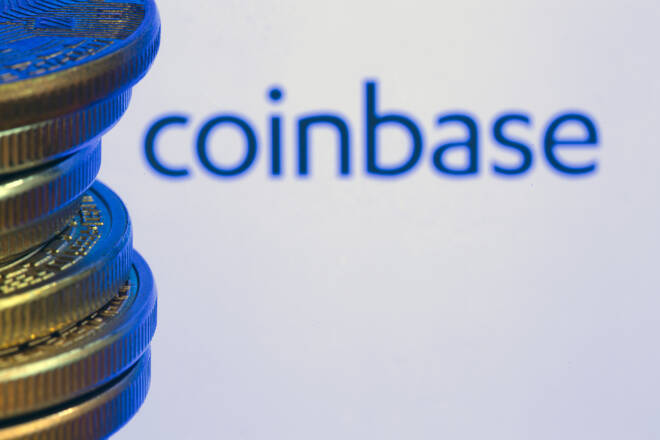Advertisement
Advertisement
The Other Side of the Coin: Can Coinbase Overcome a Slow Start on Wall Street to Recover its Value?
By:
Coinbase’s hotly-anticipated arrival on Wall Street may have been met with divided opinions over the sheer scale of the company’s $100 billion valuation on launch, but there’s very little doubting that the popular cryptocurrency exchange was one of the most curious listings of the year.
After floating on the cusp of a cryptocurrency market downturn, can we expect Coinbase to deliver a strong end to 2021 for investors?
Coinbase opted to launch on the Nasdaq via a direct listing in April 2021 with a reference price of $250 – however, the poor performance of the cryptocurrency market since the arrival of COIN and the threat of regulatory scrutiny has caused shares to dip below the company’s opening price.
Despite COIN struggling to hold its opening price, it’s important to acknowledge the company’s blistering fundamentals. Coinbase’s revenue climbed some 144% to $1.28 billion in 2020, before rocketing some 969% year-on-year to $4.03 over H1 of 2021.
The company also became profitable in 2020 with a net profit of $322 million, and accelerated these margins to net profits of $2.37 billion over the opening six months of 2021. At the same time, Coinbase’s trading volume accelerated by 142% to $193 billion in 2020, and then to $335bn and $462bn respectively across the first two quarters of 2021.
So with such mind-boggling numbers in mind, surely COIN’s poor market performance of late is merely a blip? Well, experts are split on the outlook of a stock that’s been battered by a wide range of external threats from regulators and the wider cryptocurrency market alike.
With this in mind, let’s take a deeper look into what the future holds for Coinbase as the world’s first publicly traded cryptocurrency exchange:
Arresting COIN’s Development
Despite its position as a leading cryptocurrency exchange and holding its market cap at around $50 billion at the time of writing, the outlook isn’t necessarily positive for Coinbase when considering the exchange’s exit velocity for 2021.
“In our view at the moment, it is not worth buying Coinbase shares amid recent news,” said Maxim Manturov, head of investment research at Freedom Finance Europe, in reference to SEC threats against the company’s rollout of a new lending feature and the recent decline in value of Bitcoin.
“Also, after the Q2 report, the company expects trading volumes to decline in Q3, which could lead to higher costs and lower profitability for the company,” Manturov added. “In the short term, this could put pressure on Coinbase’s price, which could lead to a weak rise in the company’s shares. For example, analysts at Mizuho Securities believe Coinbase may have lost some bitcoin market share, with retail users trading less and institutional investors’ returns continuing to fall.”
Although Coinbase has since scrapped its plans to introduce a cryptocurrency lending platform amidst threats of lawsuits from the US Securities and Exchange Commission, Manturov noted that it’s possibly worth waiting for Bitcoin to show signs of stability before looking to COIN as a long term investment option.
We’re seeing further evidence of Coinbase’s symbiotic relationship with Bitcoin in the wake of the Evergrande crisis within Chinese real estate. Although the cryptocurrency ecosystem is largely decentralized, investor sell-offs in traditional stocks, like that of Evergrande, can create profound problems in the world of digital finance – with Bitcoin’s value dropping 10% in the wake of the fire sale.
With this in mind, any investment in COIN must come with the awareness that a stock so intrinsically linked to crypto may also become severely affected by market downturns.
Luring Growth Investors
Despite there being legitimate concerns regarding the external pressures that Coinbase faces, the stock is still drawing interest from world-renowned investors.
Notably, Coinbase has lured in Cathie Wood as a speculative investor. The famed CEO of Ark Invest has allegedly built a combined interest of 5.95 million shares in Coinbase – amounting to a total of around $1.46 billion at the time of writing. This level of investment amounts to some 3.4% of total assets under management, making Coinbase one of Ark’s biggest collective holdings.
Wood’s faith in the stock stems from the wider belief that cryptocurrency adoption will continue to grow over the course of the coming decades as more companies opt to hold coins like BTC on their balance sheets.
As the data above shows, there’s a clear and sustained rise in the prevalence of blockchain-based wallets over the course of the past six years. Coinbase’s fundamentals reflect a trend towards both higher assets on platform (AOP) and consistently greater trading volumes. Though the platform makes money on both the buy and sell aspects of crypto, it’s naturally better positioned to make more money if cryptocurrency prices are trending upwards.
Although the cryptocurrency landscape is impacted by many things, inflows typically correlate with higher cryptocurrency prices as new investors are attracted to appreciating assets – whilst existing users benefit from capital gains.
With this in mind, it’s worth zooming out of Coinbase’s recent trials and tribulations and taking into account the wider cryptocurrency ecosystem. As one of the world’s first crypto-oriented arrivals on Wall Street, COIN represents an excellent opportunity for investors to speculate on the future growth of Bitcoin and Ethereum whilst staying in tune with traditional stocks. When playing the long game, a bet on Coinbase represents a bet on the cryptocurrency ecosystem – which, historically speaking, has been a highly rewarding wager of late.
About the Author
Dmytro Spilkacontributor
Dmytro is a tech, blockchain and crypto writer based in London, UK. Founder and CEO at Solvid. Founder of Pridicto, an AI-powered web analytics SaaS.
Advertisement
